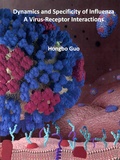Dynamics and specificity of influenza A virus-receptor interactions

Guo, Hongbo
- Promoter:
- Prof.dr. F.J.M. (Frank) van Kuppeveld
- Co-promoter:
- Dr. C.A.M. (Xander) de Haan
- Research group:
- Kuppeveld , Haan
- Date:
- March 20, 2018
- Time:
- 14:30 h
Summary
HA binding, NA cleavage and the HA/NA balance are of great importance in IAV entry, replication, release and transmission. Most existing methods for studying HA and NA activity and specificity are based on end-point assays which do not easily reveal kinetic parameters of the interactions between virus and receptor. There is a clear need for efficient and well-defined methods for studying HA and NA activities and their balance, particularly in virus particles in combination with physiologically relevant receptors. Therefore, in Chapter 2, a kinetic and label-free methodology based on BLI was established, which was used for investigating the dynamic interactions between IAV and its receptors, including HA- and NA-dependent activities and the balance between the two proteins. In addition, we demonstrated rolling of virus particles on a receptor-coated surface. In Chapter 3, we used the BLI technology to study the dynamics of IAV-receptor interactions in more detail by using different recombinant soluble glycoproteins and analyzing the ability of antibodies and mucus decoy receptors to interfere with these interactions. Among others, we showed that virus binding to receptors may become tighter in time, which we refer to as maturation of virus binding. As a further application of BLI, in Chapter 4, we analyzed the correlation between antigenic drift and virus-receptor binding of H3N2 viruses from 1968 to 2002.
In 2014 novel HPAI H5 viruses emerged that contained different NA subtypes (referred to as H5Nx viruses) and that displayed unprecedented intercontinental spread. In Chapter 5, we determined the evolutionary history of the HA proteins of these novel HP subtypes and showed that these H5 genes form a monophyletic group that evolved from a clade 2.3.4 H5N1 variant. In Chapter 6, we subsequently studied to what extent the emergence of novel HP H5Nx viruses was accompanied with changes in virus receptor binding properties using among others BLI.